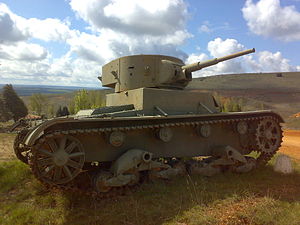Battle of Seseña
| Battle of Seseña | |||||||
|---|---|---|---|---|---|---|---|
| Part of the Spanish Civil War | |||||||
 T-26 mod. 1933 in service in the Spanish Republican Army, near Salamanca, Spain. |
|||||||
|
|||||||
| Belligerents | |||||||
|
|
|
||||||
| Commanders and leaders | |||||||
|
|
|
||||||
| Strength | |||||||
|
1st Mixed Brigade: (around 3,800 men) 15 T-26 tanks |
one cavalry column: ? regulares:? At least 11 Italian L3/33 tankettes |
||||||
| Casualties and losses | |||||||
| 8 dead 3 tanks destroyed |
Soviet claim: 600 dead 11 tankettes destroyed |
||||||
The Battle of Seseña was an ill-fated Republican assault on the Nationalist stronghold of Seseña, near Toledo, 30 km south of Madrid in October 1936 during the Spanish Civil War. After the fall of Talavera de la Reina and Toledo in September 1936, the Nationalist troops pushed towards Madrid and in October they were 30 km from Madrid. Then the Republican government which had received new Russian weapons decided to launch a counteroffensive in order to stop the Nationalist offensive at Seseña. The attack failed and the Nationalists resumed their advance towards Madrid. The battle is notable for being the first time that tank warfare was seen in the Spanish war and for the use by Nationalist troops of Molotov cocktails against Soviet T-26 tanks.
The professional troops of the Spanish Army of Africa had started their drive to Madrid in August 1936. Equipped with modern weapons they had received from Germany and Italy (Ju-52 and Savoia SM-81 planes, and Italian tankettes), the Nationalist troops, had defeated the government militias in the battles of Mérida, Badajoz, Sierra de Guadalupe and Talavera de la Reina, and had occupied Toledo on September 27, 1936. In late October 1936 the Nationalists took several towns near Madrid (Torrejon de Velasco, Seseña, Torrejón de la Calzada and Griñon), breaking the first defensive line of Madrid.
...
Wikipedia
